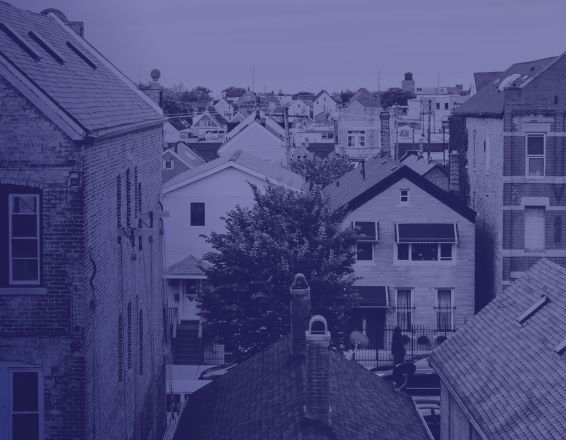What 30 Years Of Data Says About Investing In Chicago Multifamily

When he helped found Essex Realty Group in Chicago 30 years ago, Doug Imber didn’t have data collection on his mind. His love for data grew out of a penchant for hanging on to paper records.
As a broker, one of Imber’s core responsibilities was to appraise properties, helping owners determine what price they could fetch for multifamily assets in Chicago. He looked at operating statements for hundreds of properties across the city every year, logged rent rolls and expenses, found other comparable properties and recent transactions and determined fair market values. Then, even if the owner decided to work with another brokerage, Imber would tuck the data away into a filing cabinet.
“After 10 or 15 years, as we began filing all this information digitally, we realized we had rooms full of this old data,” said Imber, who now serves as president of Essex Realty Group. “Every rent comp from 1992, every tax bill from 1996 was in there, and we realized there was real value in organizing it into a robust database to help us draw conclusions and extrapolate.”
The result of digitizing the records was a remarkably complete look at multifamily statistics and trends from neighborhoods all around Chicago. For Essex, Imber said, the database has become a powerful tool for seeing how past market trends have affected prices, rent and cap rates and even for identifying the next hottest investment markets.
Click to view chart: Avg Cap Rate Compared To 1 Yr Treasury Yield
One of the most illuminating metrics Essex tracks is capitalization rates for multifamily assets by various Chicago neighborhoods. Cap rates, which divide a property’s net operating income by its value, are a measure of the return an investor can expect given an equal investment, but are more often used as a gauge for risk — the lower the cap rate, the more reliable the return.
Essex’s data bears out that second understanding of cap rates. As recessions like the tech bubble or the 2008 recession set in, cap rates spike, then drop back down as the city recovers. Established, central markets like Lincoln Park and Lakeview stay more consistent than emerging markets like Rogers Park or Uptown.
But what is remarkable for Imber is just how much cap rates for emerging markets have compressed over the last decades and how overall cap rates have trended downward in the last 30 years. That compression suggests that a wide swathe of the submarkets throughout the city have become reliable destinations for investors. The cap rate in Lincoln Park, one of the toniest neighborhoods in Chicago, has held steady since 2010, suggesting that investors who took a chance on emerging markets like Rogers Park after the last recession have seen greater appreciation than their more risk-averse counterparts.
Imber added that early data for 2020 suggests that cap rates are not spiking nearly as much as they have in earlier recessions, largely because interest rates have hit historic lows. He also expects that in the spring, college graduates will still be looking to move to the city rather than return to their childhood homes, driving new demand.
“In the 30 years that Essex has been collecting data, we’ve seen three wars, 9/11 and four major recessions, but properties have never really stopped appreciating in value,” Imber said. “Even though we’re facing headwinds now from the pandemic, the long-term outlook for Chicago is still incredibly strong across all these submarkets.”
Click to view chart: Avg Rent Growth By Select Neighborhoods
Essex’s data on rents in one-bedroom apartments shows steady growth across many neighborhoods in Chicago, but shows that investors in some areas have seen outsized returns.
“When underwriting for rent growth, you typically place it around 2.5% or 3% year-over-year,” Imber said. “But almost every neighborhood we track well exceeds those conservative estimates, some by a wide margin.”
Lincoln Park and Lakeview, perennially popular neighborhoods, saw a 5.28% year-over-year growth in rents. But Logan Square and Wicker Park, which boast trendy restaurants and quick access to the city center via mass transit, have seen 7.43% year-over-year growth in rents, and overtook Lincoln Park and Lakeview in average one-bedroom rents in the last year. Imber suggested that other emerging markets further south like Pilsen and Bronzeville may see similar growth in the coming years.
Rent growth metrics are crucial for investors who want to know how a potential acquisition may perform in the coming decades. Imber said leveraging historical data can make for more accurate predictions for future rent growth, and also give both Essex and its clients a sense of calm in these uncertain times, when rent growth is uncertain.
“We have a mandate to give people honest valuations and the best advice so that they can make good decisions for themselves,” Imber said. “The more accurate, fair and data-driven we can be, the more our clients will keep coming back.”
Since 1990, Essex Realty Group, Inc. has served Chicago’s investment real estate market as a top multifamily brokerage firm. Contact us today to learn more about our recent multifamily and mixed-use property sales.
Read Full Article at Bisnow Chicago